A perennial complaint of quite a number of Greyhawk fans is the way that the World of Greyhawk setting was altered through products such as Greyhawk Wars and From the Ashes. “Don’t advance the timeline!” is a clarion call for those who thought that the changes wrought to the setting detracted from, rather than added to, it. I used to be one of those people myself, and quite a vociferous one at that.
However, I’ve had something of a conversion on this issue after reading through and considering the implications of what is generally regarded as one of the classic fantasy RPG supplements in recent years; The Great Pendragon Campaign. TGPC takes the players on a multi-generational campaign which starts in the year 485 CE and ends in 566. During this time, the various ups and downs, plots, events, notable NPCs who wax and wane, etc. are all laid out for the game master’s use. It is, by its very nature, “advancing the timeline” and it does so brilliantly.
My question becomes, why is it okay for TGPC to sweep the campaign along an 80-year course, but when several products take the World of Greyhawk from 576 CY (the year in which the folio and first boxed set took place) to 585 (Greyhawk Wars), to 586 (From the Ashes) to 591 (The Adventure Begins – a total of 15 years), that somehow ruins the setting? I’m assuming the same could be said of the Forgotten Realms, but I’m not nearly as acquainted with its fans as I am with Greyhawk fans.
Now, I can completely understand if fans of the setting don’t like some of the specific events and themes that the later additions introduced. Having demons and devils running around the Flanaess, only to mysteriously vanish, having the western Sheldomar Valley overrun by giants and monsters, assassinating most of the members of the Circle of Eight, etc. could all be design choices that an individual DM could decide didn’t fit in with his conception of how he wants to run his campaign. Absolutely understandable, and I’m not saying that’s not perfectly within the DM’s rights.
However, over the years, the objections I’ve most often seen in regards to this phenomenon and Greyhawk haven’t been with the specifics of the changes, but with the fact that the timeline for the campaign advanced at all. Given the scales of most campaigns with which I’m familiar, having big political and military changes going on in the background wouldn’t seem to interfere with the flow of the campaign. Even in a campaign that focuses on the player characters in political and military roles themselves, I would think that having some framework into which their actions can be plugged on the larger stage would be helpful.
Historically, of course, borders change all the time, even to the extent that entire nations disappear and new ones rise. Take a look at these two maps of Europe; the first showing the borders as of 1360 CE and the next the borders as of 1400. France has taken over almost all English territory on the Continent, the Turks have taken over a goodly chunk of the Balkans, the Golden Horde is pushed out of the Caucasus, Poland and Lithuania are merged, etc.
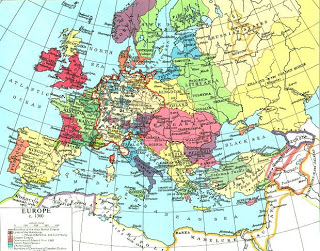 |
| Europe 1360 |
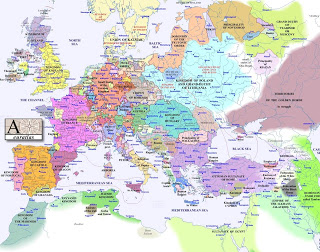 |
| Europe 1400 |


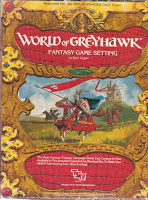
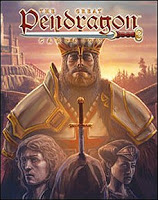
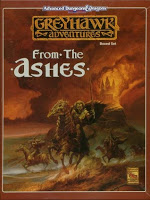







I think that people object because it feels like a product treadmill. This is more of an issue when, say, half your players are really into the setting canon and others are not. Luckily, I have never had to deal with that myself, but I have read about it being a problem. Also, divergence from the published setting can get confusing for players if the metaplot advancement includes mechanical elements like spells, powers, classes, or whatever. For those of us used to houseruling like crazy this is not a problem.
I would argue that, when it comes to Pendragon, there's a reason behind the advancement of the timeline: the game is based on real-world legend. The mythology of King Arthur has a clear progression, the life of Arthur and his many adventures and tribulations. Thus, I think there would have been complaints if Pendragon DIDN'T advance the timeline!
With regard to Greyhawk, I can sort of see why people wouldn't want the timeline to advance: because many gamers want to advance the storyline as they see fit, organically, in the progress of their campaigns as the result of player choices. They don't want to be told how the future unfolds, since they're creating that future with every game session. Being told by the publisher how things shake out is tantamount to railroading, wouldn't you agree?
Agree with Brendan… but additionally, it seems like too much was written just to capitalize on characters that were meant to be part of the background mystery.
Vecna, Iggwilv, Acererak, etc. should have been left alone. The more written about such characters, the more the setting canon became so solid until it finally stopped being a true setting altogether.
Even having to glue a campaign to a particular year kills the spontaneity. With all the details and overwritten canon, Greyhawk has become… a (fictional) historical setting…
I agree with you wholeheartedly, scottz, about the use of characters like Vecna and Acererak (and, I might even argue, Iuz). They should have been left as mysteries that were left to the DM to flesh out or not; their coolness was diminished by their active presence in the setting.
However, Drance, I still don't agree that having some sort of timeline available constitutes railroading.
Bear in mind that railroading, as typically used in an RPG context, generally refers to forcing the player characters to perform certain actions in order to advance the story. The sort of timeline that Greyhawk has had is something of the reverse of that; the metastory is happening around the characters, and the players get a real sense that the world will continue moving and evolving even if their characters weren't there.
The characters are not being forced to participate– it merely provides them an ever-changing tableau against which they can undertake their own adventures. Sometimes they can opt to get involved with those changes, other times not, but I would argue that the mere existence of a timeline does not compel the player characters to participate in how it unfolds regarding specific events.
I think a lot of the problem was the spirit of the changes. Everything was being done to "officially" change the world that Gary had created, and override the original Greyhawk setting by fiat. I mean, Greyhawk Wars was not long after the atrocious Rose Estes novels and the fake "Castle Greyhawk" that was released literally as a parting shot at the real Greyhawk's creator. It wasn't just that things were changing, but they were changing in a way that was specifically meant to wreck Gary's setting. It rode roughshod over his own direction, and changed the whole tone of the setting.
I came around to Sargent's work a couple of years after it was out and a year or so before the new material (Return of the Eight, The Adventure Begins etc). I think he made a silk purse out of a sow's ear, and particularly I loved the Marklands and Ivid the Undying books (the latter of course released online-only). This was a vivid, disturbed medieval fantasy setting. I still think an ItU-era Rauxes would make a brilliant "outdoors dungeon" adventure.
Then Roger Moore and a couple of other well-meaning types tried to "fix" everything, and they went onto a new status quo that didn't quite fit anybody. Most of the interesting plot hooks from the Sargent era were wrapped up in uninspiring ways, particularly how virtually all of the material from Ivid was made useless with the final split between Ahlissa and North Province, but it was still substantially different from 576 era Greyhawk. It also cemented the rather uninspired take from the City of Greyhawk boxed set.
I realize that this is all specific griping, which is mostly hashed up from last century. But I think it indicates at least part of the problem: every time they retooled Greyhawk, they did it in such a way as to make the feel and much of the detail of the specific material that had been released before, invalid. This was a fairly big thing in that final block of supplements, considering they detailed the Pomarj, Geoff, and Sterich in a series of adventures (Slavers / Against the Giants: the Liberation of Geoff) and then did a big sourcebook on the Scarlet Brotherhood, Hepmonaland and the Amedio Jungle.
I think quite a lot of the conceptual approach for "don't advance the timeline" came from disappointment with all of that. If it had been something as epic and awesome as the Pendragon campaign, then attitudes likely would have been a lot different.
@Joe: I forgot about Iuz… totally agree.
Would it have been better if they removed the actual characters turned NPC's? (Would it have helped if entities like the Circle of Eight wasn't included at all?)
Characters/NPC's are canon 'mountpoints' as much as maps or gazetteers are, IMHO.
I'm actually quite thankful for those who contributed to Greyhawk canon after Gary left. From my point of view, as both a Greyhawk fan, a FR fan and an occasional reader of Dragonlance and Mystara stuff, the 2nd Edition Greyhawk stuff kept the world in print, and in my consciousness while other worlds and games were competing for my attention. Could they have printed more Greyhawk products without advancing the timeline? Yes, but I'm not sure if they would have reprinted the World of Greyhawk boxed set without significant changes.
Also I agree with Joseph here that geopolitical events happening outside the PCs control does not constitute railroading. The PCs are the centre of the game, not the centre of the World of Greyhawk. Things can and will happen in far-off lands without the PCs getting involved.
Echoing what has already been said. There is a coherency to the Pendragon tales as it was based off the various tales of King Arthur that have been entered into the collective consciousness. The timeline was probably written out for the product as "one" effort. Gary Gygax put together the original Greyhawk timeline and it has a cohesive feel. My objection is when a new team is assembled, and they go about "rebooting" the campaign. It never feels the same. Forgotten Realms spell plague is just blah. The recent WoTC "rebooting" of DarkSun, and Forgotten Realms (writing in Dragonborne into the timeline) is particularly annoying.
@Mr. Bloch: You're right, the use of the term "railroading" in this instance was a bit premature on my part. You make a good point. Ultimately, published materials that advance timelines should be used with common sense by a DM/GM, when it comes to incorporation into a campaign. If what you and your players have done in actual gameplay differs from what designers have dreamed up, I would hope that most GM's would have the sense to defer to his/her own group's organically-created timeline, and not try to shoehorn an existing campaign into "canonical" timeframes! Again, this should be common sense, but stranger things have happened!
My comment is that the campaign setting for FR and Greyhawk were static. You got the history before the first year of the campaign, and then you're encouraged to take it from there and go with whatever you feel happens next.
I think if they took the first box set that came out and had the timeline where the Greyhawk Wars, From the Ashes, and The Adventure Begins was detailed and then told the DM, "Your campaign starts in CY 576 (or earlier)" then you have GMs who are planning their campaigns with the upcoming events in mind. The exception would be those who don't like them and create their own timeline.
Books, adventures, and supplements that come out further detailing the future events would come as no surprise, and it's unlikely it would get the nerdrage of, "They are killing my campaign with all these changes!" etc., etc.
I love this topic! Good responses so far. I for one like advancing the timeline as long as there is a smooth, logical progression, which Greyhawk did have for better or worse (FR did not). In my own campaigns back in 1E I followed the cues from Gygax's articles about the political-military build up in Greyhawk. Those articles meant for the timeline to move, so by the time the 2e Sargent era came along my own campaign was decades ahead of the official timeline, but I made due.
As for a good starting place, lately I favor returning to the 1e era @576 CY and from there cherry picking events I want from later editions.
@mortellan: I can get behind that – the later published canon becomes raw source material for your campaign.
If we could go back in time, take the Gazetteer as the last solid piece canon, and make a bunch of alternates expanding out from there as a series of 'what if' products, would it have been more useful to DMs? (i.e. 'what if Iuz ruled?', 'what if the ToEE never fell?', 'what the Giants won?', etc.)
Why is it OK for the The Great Pendragon Campaign?
Because if you do something well, you earn the right to break all the rules.
I don’t see how publishers can successfully advance the timeline the way they did for Greyhawk and FR since declaring some such advance canon basically says that your campaign is going to have trouble using all future products for this setting unless somehow our official timeline happened to match what happened in your campaign.
That said, I’m clearly not the one buying all those products, so it appears to be working for the people who do buy them.
I’d be more likely to use a published setting, however, if I knew there was a single, evergreen player’s guide that I could refer players to. If players have to go searching for an out-of-print one or get one that doesn’t match the baseline I’m working from, then I might as well be creating my own setting rather than using a published one.
"Mr. Bloch"?
When did my dad leave a comment here?
Allow me to come at this from the other end of things. I am a Pendragon player and GM at heart, and I run the GPC every month. The whole point of Pendragon, the way the game it set up, is to mirror the legend of King Arthur, which is a multi-generational story. D&D has always been about the current characters and that's that.
Does this mean that D&D cab't behave like Pendragon? Nope. I ran a D&D game, before I got into Pendragon, that took the characters from 1st level to 15+, and it was spaced out over several years of game time. They went from tracking down a small time villain to being involved in a war for the planet. Admittedly, this was done without published materials, so I wasn't forced into anything.
However, having an overarching timeline, whether it be from published materials or from DM creativity, can add some good flavor to a campaign, even if the players never go beyond the next dungeon. When they return to town, a new flag is flying over the walls and they are asked for travel papers. Well, they probably should have listened to those rumors about hostilities breaking out between this kingdom and the neighbor.
Just my $0.02.
An interesting thread.
I personally loathed the advanced timeline when it came out, but never really stopped to analyse why. I had no objection to the principle, heck I loved the Dragon magazine features from Gary that outlined future events and was building towards the big conflict. On reflection it was the execution.
Now execution will always be a subjective matter. Personally I liked the way that Gary set out Greyhawk, it felt well crafted and I liked the tone. What followed did not feel on par. That is not to say it was poor (although I have strong personal views on some of the material!) but it just didn't click for me. In many respects the tone felt heavy handed and clumsy, the changes too sweeping and without credibility.
So I agree that a progression is both desirable and a great backdrop to a campaign, but like Mortellan I have come to use the post 576 material as a mine, adjusting it to my own tastes.
What would I like to see in any advance? Well firstly I think it should be a backdrop and a light touch. By all means outline the political and military action, but don't dictate what the outcome is for core NPCs. If I want to kill off members of the Circle of Eight leave that to me please!!. Secondly, lets have the villans stay in the shadows for the DM to use. As has already been stated, too many protagonists have their stories laid out… Thirdly ease up on the 'world turning events'. What I disliked about the post 576 events was the scale. It felt manufactured, as though every comer of the Flanness had to be embroiled, even if that meant creating a convenient pretext. Yes an Iuz / Furyondy / Veluna conflict. Yes an Great Kingdom disintegration at the same time, with ripples affecting the surrounding states…. and that suffices for a grand scheme of events. I am not saying that other areas will not see conflict, but lets keep things a little measured. That is the style which I came to expect from Gary and which I felt served the setting well. The danger of supercharging change (remember Fate of Istus had only just gone before…) is that I feel it makes the setting a parody of itself.
I trust nobody takes what I am saying amiss. I do not contend that one incarnation is better than another, but for me the adage less is more holds true….. By all means give my sandbox some texture, but don't go shoving great sandsculptures everywhere so that I have no room to play 🙂
It's not the same because, well, WoGH isn't a campaign so much as a campaign *setting*. It's up to the individual DM's to decide how to advance the timeline in their own campaigns. The closest thing that I recognize as being "official" advancements for WoGH are the articles Gary and Rob did in "Dragon" that outlined specific happenings around the Flanaes.
By the time the Greyhawk Wars, From the Ashes, et. al. came around I had stopped playing AD&D and didn't get back into things for several years. When I did what hit me was 1) the *seeming* purposeful de-Gygaxing of the setting, and 2) the fact that such meta-camapaign events seemed to go against the previous idea that the setting was barebones specifically to allow the DM develop things as he wished. Bit and pieces, new details, etc. were added with new products (such as the information found in T1-4 and S4) but this type of presentation made it easy for the DM to adopt how much he wanted and in a manner he wanted. Large advancements of a supposed "Greyhawk Campaign" work against this basic idea.
Any DM should be able to run a campaign in WoGH and have it develop in a manner completely unique. Having a meta-campaign with major developments that have to be assimilated can potentially work against this, I think. Campaign-shaking developments are great. As long as they are developed by the interaction between the DM and the players.
There are games and/or settings where this type of development is built in. For Greyhawk, however, it seems to be a non-organic add on by people who weren't particularly interested in preserving the Gygaxian flavor of the setting in the first place.
YMMV, of course.
Having a meta-campaign with major developments that have to be assimilated can potentially work against this, I think.
So do you also think that the Gygax/Kuntz "Events in the Flanaess" articles in Dragon magazine should be discarded as a meta-campaign?
I ask because your other statements seem to say that it would be okay if Gygax did it, but the real problem is the fact that other people did it to turn it away from his original vision.
In that case, it doesn't speak to my original point, which is that I don't have a problem with meta-plots and advancing the timeline in general, even though everyone is going to have some issue with how they are enacted specifically.
Since others have already voiced most of my complaints with the "adjustments" to the WoG setting, I'll just say this:
Having anyone other than Gary make changes to the WoG is, in my mind, the difference between an artist making adjustments to a painting and a vandal drawing a mustache on the mona lisa.
"So do you also think that the Gygax/Kuntz "Events in the Flanaess" articles in Dragon magazine should be discarded as a meta-campaign?"
I think they certainly can be and more easily than things like the Greyhawk Wars. The only thing I can think of, off hand, that those articles do to change the setting itself is in the Hold of Stonefist. The Greyhawk Wars and From the Ashes changed the setting on a much wider basis and in a manner which is much harder to do than ignoring one article in "Dragon."
As I stated the Gygax/Kuntz articles were "the closest that I recognize" to being campaign advancement for WoGH. But, as I pointed out already, Greyhawk is *not* a campaign, it's a setting. As such it was developed, and serves best as, a place in which gaming groups form their own history. If people want to play in a meta-campaign there are settings and products for that, too.
Having anyone other than Gary make changes to the WoG is, in my mind, the difference between an artist making adjustments to a painting and a vandal drawing a mustache on the mona lisa.
Rob Kuntz, Frank Mentzer, Jim Ward, Francois Marcela Froideval, Tim Kask, and Len Lakofka might disagree with you on that particular point. 😉
Having anyone other than Gary make changes to the WoG is, in my mind, the difference between an artist making adjustments to a painting and a vandal drawing a mustache on the mona lisa.
Rob Kuntz, Frank Mentzer, Jim Ward, Francois Marcela Froideval, Tim Kask, and Len Lakofka might disagree with you on that particular point. 😉
Some vandals do draw more pleasing mustaches than others.
Indeed. Pleasing, even, to DaVinci himself. 😉
Others have already argued the point well. For myself, I don't mind timelines if they are well designed (as the Great Pendragon Campaign is), but I loathe them if they are not (as the atrocities performed on the Greyhawk setting are). That is to say, you can gain a little bit with a good timeline, but you lose everything with a badly-done one. When the changes wrought are done simply to erase the legacy of an out-of-favor founder (and yes, I am also talking about AD&D here, though the fact that it is as good as it is speaks volumes to Gary's genius), then it is even worse.
And who really needs a World War II in a fantasy setting, anyway?
As for the "Events in the Flanaess" series, I have long maintained that those were Gary's biggest mistake with regard to the Greyhawk setting.
I have always felt that the some of the best work done in my own homebrew was the advancement of the game's timeline taking into account the actions of the players (and other adventurers) so that all subsequent games would be affected by said action. Keeping this in mind, I can see why it would irk people to have setting material that was constantly updated, but I believe it really depends on your flexibility and willingness as a DM and setting-arbiter to incorporate the changes that work and the changes that don't.
All campaigns, particularly those based on published settings, represent a single variant of time. I like to think of any given instance of the Realms or Greyhawk as running parallel to any other. In "our" Realms, for example, there was a major crisis in Thay just before the Time of Troubles: not necessarily true in many other versions.
For that matter, published setting timeline-advancement should be read as a suggestion IF IT FITS IN with your own version of the setting that you personally run. Because as soon as you run anything in any setting, you are essentially devolving a branch of it just for you.
Insofar as the "reboots" go, I hold no truck with them. I find them to be garish efforts at hitting a reset button that, really, was not needed in the first place as long as DMs followed the general idea that "their" version of a campaign was just that—a version.
The reboots seem to pander to an audience obsessed with telling stories about the best (most important, most heroic) heroes in the setting, meaning that other heroes that came before have to be narrative swept aside. That rankles me and conflicts badly with my playstyle, which is why I choose to ignore huge setting-resetting events.
Timelines are "good" if they promote certain things we happen to like – whereas it is just as sensible to totally disregard them with reckless abandon for the "good" of the campaign.
A grain of salt should be applied.
Grayhawk campaigning is great, no matter which direction the dogs of war are unleashed.
This is one reason, for myself, I have begun sketching out an Yggsburgh campaign. It is fresh, unbroken ground that will surely never see any further advancement. It will forever be "Point Zero" for anyone wishing to springboard from it.
Semi-off topic: I played Living Greyhawk extensively as part of the 3rd edition release, from 2000 through 2003 or so. My recollection was that it was post Greyhawk Wars, as my home state (Texas) was in the Bandit Kingdoms, which had been absorbed into the Empire of Iuz along with the former Horned Society and most of the Shield Lands.
I enjoyed the hell out of it. It was, despite its numerous warts, the best Organized Play experience I've ever had, and I played out-of-region quite often. There was a remarkable effort to work with the then-existing canon without changing it. Certain topics were simply "off limits," such as the mysterious metal cylinder in the Barrier Peaks …
All this is to say that I don't have an issue with updating the canon if it's well-done. I think the WoG setting would have been better served with more regional content (say, a detailed look at the Iron League, Keoland & fiefs, etc.) as well as more adventures, though I know they are less profitable than the stuff that DMs AND players can buy.